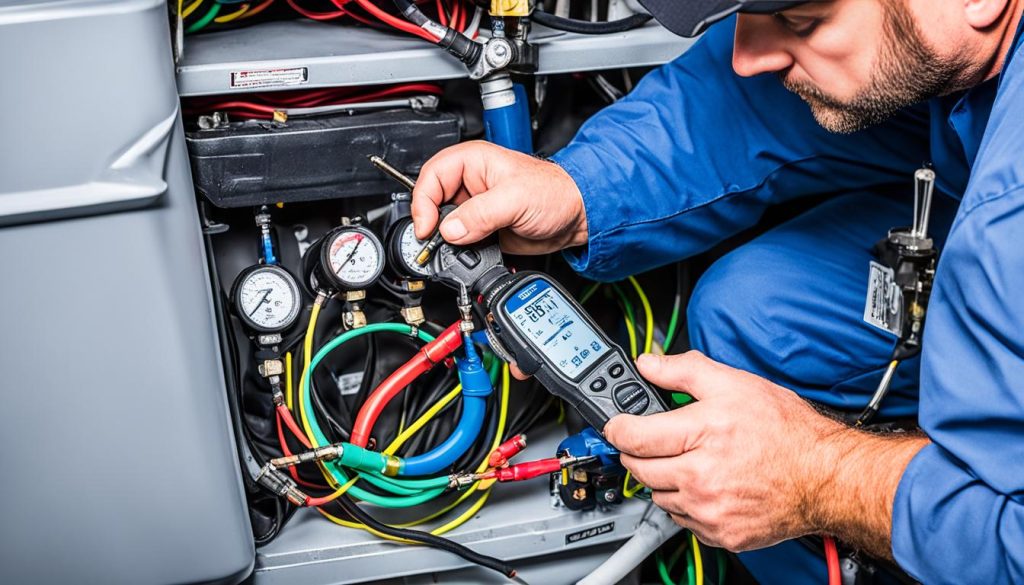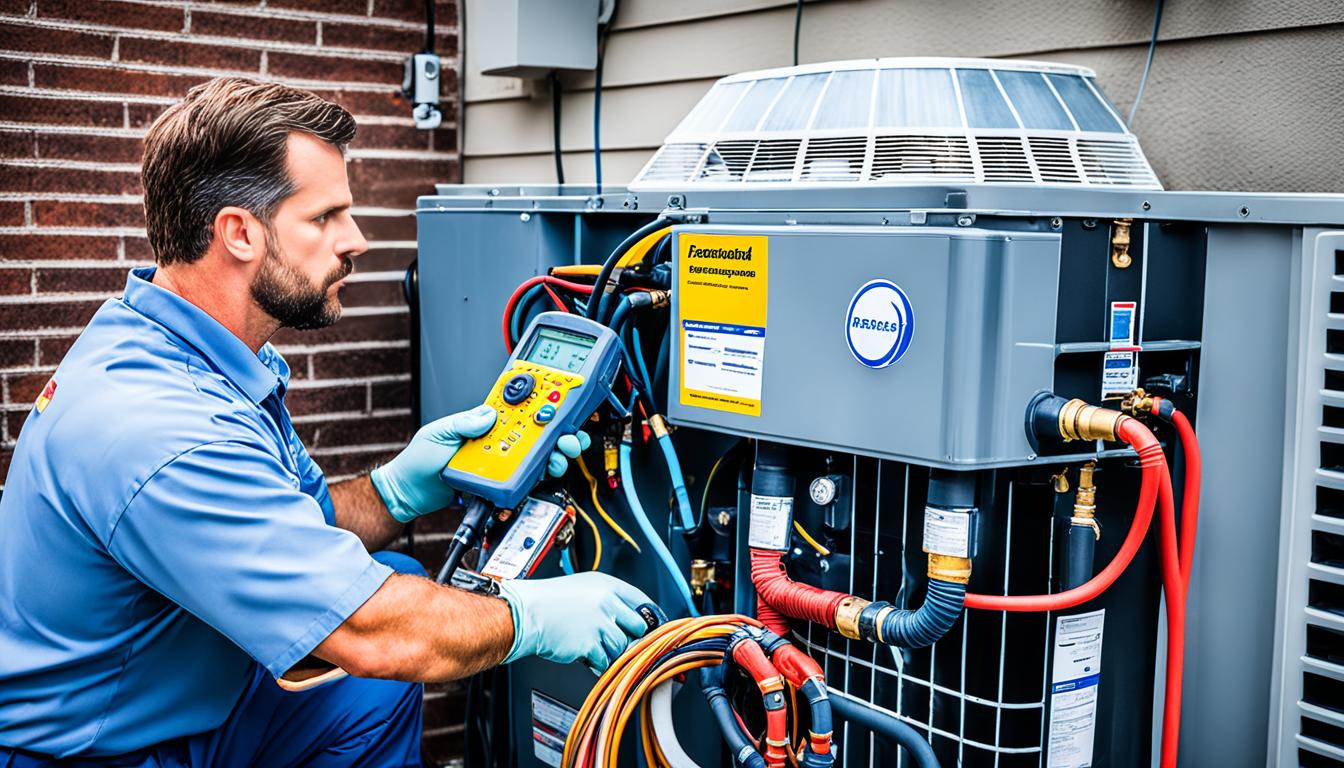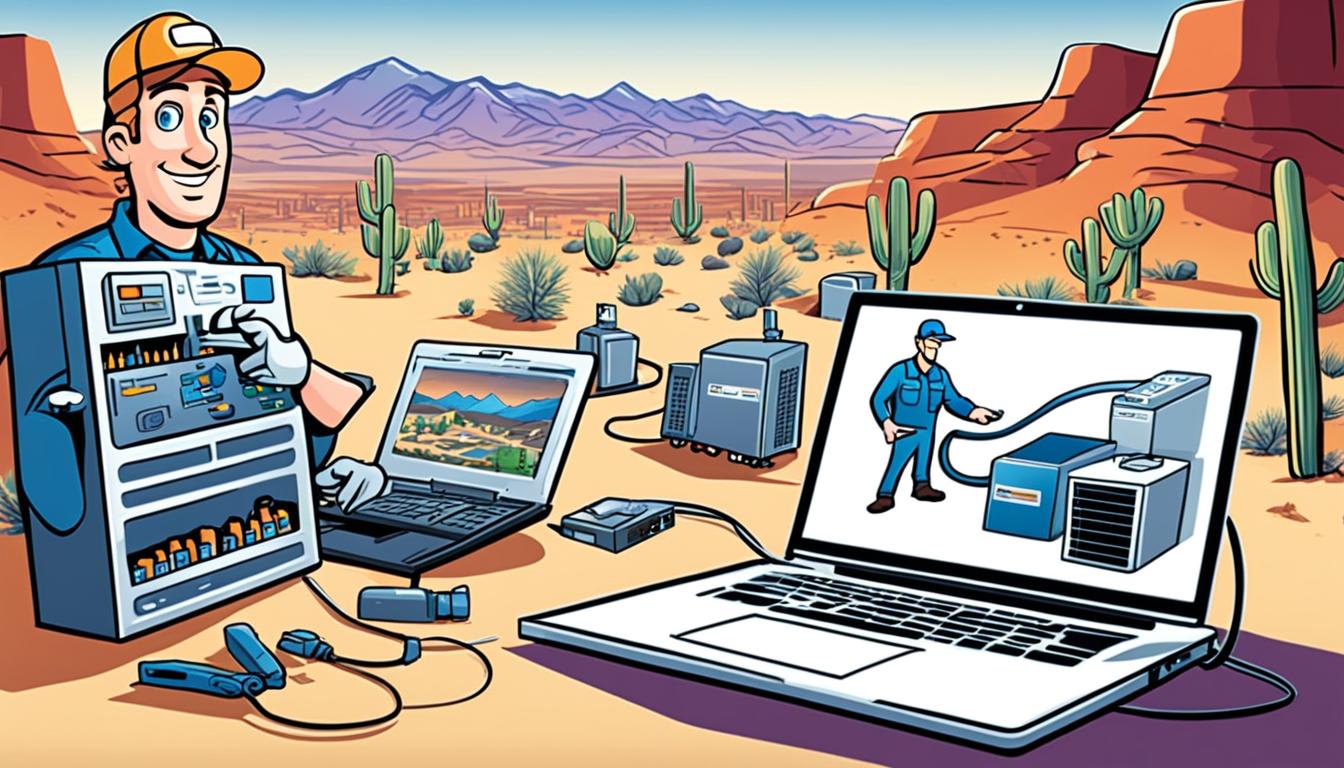Imagine this: it’s a scorching summer day and you walk into your client’s home, ready to save the day by fixing their malfunctioning air conditioning system. As you approach the unit, you notice something alarming – a refrigerant leak. Your heart sinks as you realize the potential consequences: reduced cooling efficiency, higher energy bills, and a disappointed client.
Refrigerant leaks are a common problem in HVAC systems, and they can be a nightmare for both homeowners and AC repair contractors like you. To effectively address these leaks, it’s crucial to understand their common causes and how to detect them. By equipping yourself with this knowledge, you can provide efficient and reliable solutions, ensuring the comfort and satisfaction of your clients.
Key Takeaways:
- Refrigerant leaks in HVAC systems can cause reduced cooling efficiency and higher energy bills.
- Common causes of refrigerant leaks include normal wear and tear, pinhole leaks from formic erosion, poor installation, and factory flaws.
- Signs of a refrigerant leak include reduced cool air output, extended cooling time, increased energy bills, ice buildup on the AC unit, and unusual hissing sounds.
- Detecting and repairing refrigerant leaks requires the use of a refrigerant leak detector and disassembly of the unit.
- Prompt repair of refrigerant leaks is essential to prevent further damage to the HVAC system and avoid the consequences of refrigerant leaks.
How to Identify Refrigerant Leaks in an HVAC System
If you suspect a refrigerant leak in your HVAC system, it is essential to identify and address the issue promptly to prevent further damage. There are several signs you can look out for that indicate the presence of a refrigerant leak. By recognizing these signs early on, you can avoid costly repairs and ensure the efficient operation of your AC unit.
- Reduced cool air output from the vents: If you notice that the cool air coming from your vents is weaker than usual or doesn’t reach the desired temperature, it could be a sign of a refrigerant leak. Insufficient refrigerant levels can impede the cooling process, resulting in diminished airflow and discomfort in your space.
- Longer cooling times for the home or office: Are you finding that your HVAC system is taking longer than usual to cool your space? If so, a refrigerant leak may be to blame. Insufficient refrigerant levels make it harder for your AC unit to regulate the temperature effectively, leading to extended cooling cycles.
- Significantly higher energy bills: A sudden increase in your energy bills with no other explanation could indicate a refrigerant leak. When the refrigerant levels are low, your AC system has to work harder to achieve the desired cooling effect, resulting in increased energy consumption.
- Ice buildup on the AC unit: The presence of ice on your AC unit is a clear sign of a refrigerant leak. When refrigerant levels are low, the remaining refrigerant can freeze, causing ice to form around the unit. Ice buildup can impede proper airflow and put additional strain on your system.
- Unusual hissing sounds coming from the unit: If you hear hissing or gurgling sounds coming from your HVAC system, it could indicate a refrigerant leak. These sounds occur when refrigerant escapes from the system and release pressure.
If any of these signs are present in your HVAC system, it is crucial to contact a professional AC repair contractor. They have the expertise and tools necessary to diagnose and repair refrigerant leaks effectively. Ignoring the issue can lead to further damage to your system and potentially compromise its lifespan. Don’t wait until it’s too late; act promptly to address refrigerant leaks and ensure the optimal functioning of your HVAC system.
Common Causes of Refrigerant Leaks in HVAC Systems

Refrigerant leaks in HVAC systems can be a frustrating and costly problem to deal with. Understanding the common causes of these leaks is crucial for AC repair contractors to effectively diagnose and address the issue. By addressing these root causes, you can prevent future refrigerant leaks and ensure the optimal performance of the HVAC system.
1. Normal Wear and Tear
One of the most common causes of refrigerant leaks is normal wear and tear on the HVAC unit. Over time, the connections and rubber seals within the system can become weakened, leading to leaks. Regular maintenance and inspections are essential to catch these issues early on and prevent further damage.
2. Pinhole Leaks
Pinhole leaks are another prevalent cause of refrigerant leaks in HVAC systems. These tiny holes are often caused by formic erosion in copper coils. The corrosive nature of formic acid gradually eats away at the metal, resulting in leaks. Detecting pinhole leaks can be challenging, but using a refrigerant leak detector can help pinpoint their location.
3. Poor Installation
Improper installation of HVAC equipment is a frequent culprit behind refrigerant leaks. Connections that are over-tightened or flare connections that are not properly sealed can lead to leaks. Hiring a trusted and experienced HVAC contractor for installation is crucial in preventing these issues from occurring in the first place.
4. Factory Flaws
Factory flaws in the HVAC equipment itself can also contribute to refrigerant leaks. These flaws may include manufacturing defects or faulty components that can deteriorate over time. While these types of leaks are less common, they can still occur. Regular maintenance and inspections can help catch any potential factory flaws early on.
To prevent refrigerant leaks in HVAC systems, it is essential to schedule regular maintenance and inspections. This preventative approach allows for the early detection of any potential issues, helping address them before they escalate into significant leaks. Additionally, proper installation by a trusted HVAC contractor is crucial in ensuring the system’s longevity and performance.
If a refrigerant leak does occur, it is important to contact a professional AC repair contractor to fix the issue promptly. Attempting to fix the leak yourself can result in further damage to the system and potential safety hazards. Trust the expertise of a trained professional to efficiently address refrigerant leaks and maintain the optimal functioning of the HVAC system.
| Common Causes of Refrigerant Leaks | Prevention Tips |
|---|---|
| Normal wear and tear on HVAC unit | Schedule regular maintenance and inspections |
| Pinhole leaks caused by formic erosion | Use a refrigerant leak detector for early detection |
| Poor installation | Hire a trusted and experienced HVAC contractor |
| Factory flaws in equipment | Regular maintenance and inspections to catch potential issues |
Repairing Refrigerant Leaks in HVAC Systems
Repairing refrigerant leaks in HVAC systems is a critical task that should be handled by a professional AC repair contractor. These leaks can have severe consequences if left unattended. Locating the leak can be challenging since most leaks are slow and not easily visible to the naked eye. That’s where refrigerant leak detectors, commonly known as sniffers, come in handy. These specialized tools help identify the precise location of the leak.
Once the refrigerant leak is detected, it’s crucial to follow a systematic repair process. First, the refrigerant needs to be released from the system to ensure a safe working environment. Then, the hole causing the leak must be repaired using appropriate methods and materials. It’s important to note that repairing the leak isn’t sufficient; the system must also be thoroughly evacuated of air and moisture before adding new refrigerant. Failure to perform this step can lead to further issues down the line.
The process of repairing refrigerant leaks may involve disassembling significant parts of the HVAC unit, which can be time-consuming. However, it’s best to address the issue promptly to prevent further damage and to ensure the system operates at its optimal efficiency. By repairing refrigerant leaks, you can avoid the consequences that come with them. These consequences include reduced cooling efficiency, higher energy bills, and potential health hazards caused by the release of harmful gases into the environment.





0 Comments